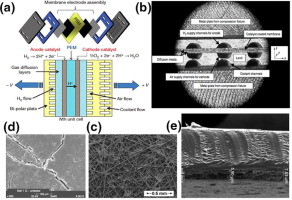当前位置:
X-MOL 学术
›
Mater. Today
›
论文详情
Our official English website, www.x-mol.net, welcomes your
feedback! (Note: you will need to create a separate account there.)
Materials, technological status, and fundamentals of PEM fuel cells – A review
Materials Today ( IF 21.1 ) Pub Date : 2020-01-01 , DOI: 10.1016/j.mattod.2019.06.005 Yun Wang , Daniela Fernanda Ruiz Diaz , Ken S. Chen , Zhe Wang , Xavier Cordobes Adroher
Materials Today ( IF 21.1 ) Pub Date : 2020-01-01 , DOI: 10.1016/j.mattod.2019.06.005 Yun Wang , Daniela Fernanda Ruiz Diaz , Ken S. Chen , Zhe Wang , Xavier Cordobes Adroher

|
Abstract PEM (Polymer Electrolyte Membrane) fuel cells have the potential to reduce our energy use, pollutant emissions, and dependence on fossil fuels. In the past decade, significant advances have been achieved for commercializing the technology. For example, several PEM fuel cell buses are currently rated at the technical readiness stage of full-scale validation in realistic driving environments and have met or closely met the ultimate 25,000-h target set by the U.S. Department of Energy. So far, Toyota has sold more than 4000 Mirai PEM fuel cell vehicles (FCVs). Over 30 hydrogen gas stations are being operated throughout the U.S. and over 60 in Germany. In this review, we cover the material, design, fundamental, and manufacturing aspects of PEM fuel cells with a focus on the portable, automobile, airplane, and space applications that require careful consideration in system design and materials. The technological status and challenges faced by PEM fuel cells toward their commercialization in these applications are described and explained. Fundamental issues that are key to fuel cell design, operational control, and material development, such as water and thermal management, dynamic operation, cold start, channel two-phase flow, and low-humidity operation, are discussed. Fuels and fuel tanks pertinent to PEM fuel cells are briefly evaluated. The objective of this review is three fold: (1) to present the latest status of PEM fuel cell technology development and applications in the portable and transportation power through an overview of the state of the art and most recent technological advances; (2) to describe materials and water/thermal transport management for fuel cell design and operational control; and (3) to outline major challenges in the technology development and the needs for fundamental research for the near future and prior to fuel cell world-wide deployment.
中文翻译:

PEM 燃料电池的材料、技术现状和基本原理——综述
摘要 PEM(聚合物电解质膜)燃料电池有可能减少我们的能源使用、污染物排放和对化石燃料的依赖。在过去的十年中,该技术的商业化取得了重大进展。例如,目前有几辆 PEM 燃料电池客车在现实驾驶环境中处于全面验证的技术准备阶段,并已达到或接近达到美国能源部设定的 25,000 小时的最终目标。迄今为止,丰田已售出 4000 多辆 Mirai PEM 燃料电池汽车 (FCV)。美国有 30 多个氢气站正在运营,德国有 60 多个。在这篇评论中,我们涵盖了 PEM 燃料电池的材料、设计、基础和制造方面,重点关注便携式、汽车、飞机、在系统设计和材料方面需要仔细考虑的空间应用。描述和解释了 PEM 燃料电池在这些应用中对其商业化所面临的技术现状和挑战。讨论了对燃料电池设计、运行控制和材料开发至关重要的基本问题,例如水和热管理、动态运行、冷启动、通道两相流和低湿度运行。简要评估了与 PEM 燃料电池相关的燃料和燃料箱。本次审查的目的有三个:(1)通过对现有技术和最新技术进步的概述,介绍 PEM 燃料电池技术在便携式和运输电源中的发展和应用的最新状态;(2) 描述燃料电池设计和运行控制的材料和水/热运输管理;(3) 概述技术发展中的主要挑战以及在不久的将来和燃料电池全球部署之前对基础研究的需求。
更新日期:2020-01-01
中文翻译:

PEM 燃料电池的材料、技术现状和基本原理——综述
摘要 PEM(聚合物电解质膜)燃料电池有可能减少我们的能源使用、污染物排放和对化石燃料的依赖。在过去的十年中,该技术的商业化取得了重大进展。例如,目前有几辆 PEM 燃料电池客车在现实驾驶环境中处于全面验证的技术准备阶段,并已达到或接近达到美国能源部设定的 25,000 小时的最终目标。迄今为止,丰田已售出 4000 多辆 Mirai PEM 燃料电池汽车 (FCV)。美国有 30 多个氢气站正在运营,德国有 60 多个。在这篇评论中,我们涵盖了 PEM 燃料电池的材料、设计、基础和制造方面,重点关注便携式、汽车、飞机、在系统设计和材料方面需要仔细考虑的空间应用。描述和解释了 PEM 燃料电池在这些应用中对其商业化所面临的技术现状和挑战。讨论了对燃料电池设计、运行控制和材料开发至关重要的基本问题,例如水和热管理、动态运行、冷启动、通道两相流和低湿度运行。简要评估了与 PEM 燃料电池相关的燃料和燃料箱。本次审查的目的有三个:(1)通过对现有技术和最新技术进步的概述,介绍 PEM 燃料电池技术在便携式和运输电源中的发展和应用的最新状态;(2) 描述燃料电池设计和运行控制的材料和水/热运输管理;(3) 概述技术发展中的主要挑战以及在不久的将来和燃料电池全球部署之前对基础研究的需求。









































 京公网安备 11010802027423号
京公网安备 11010802027423号